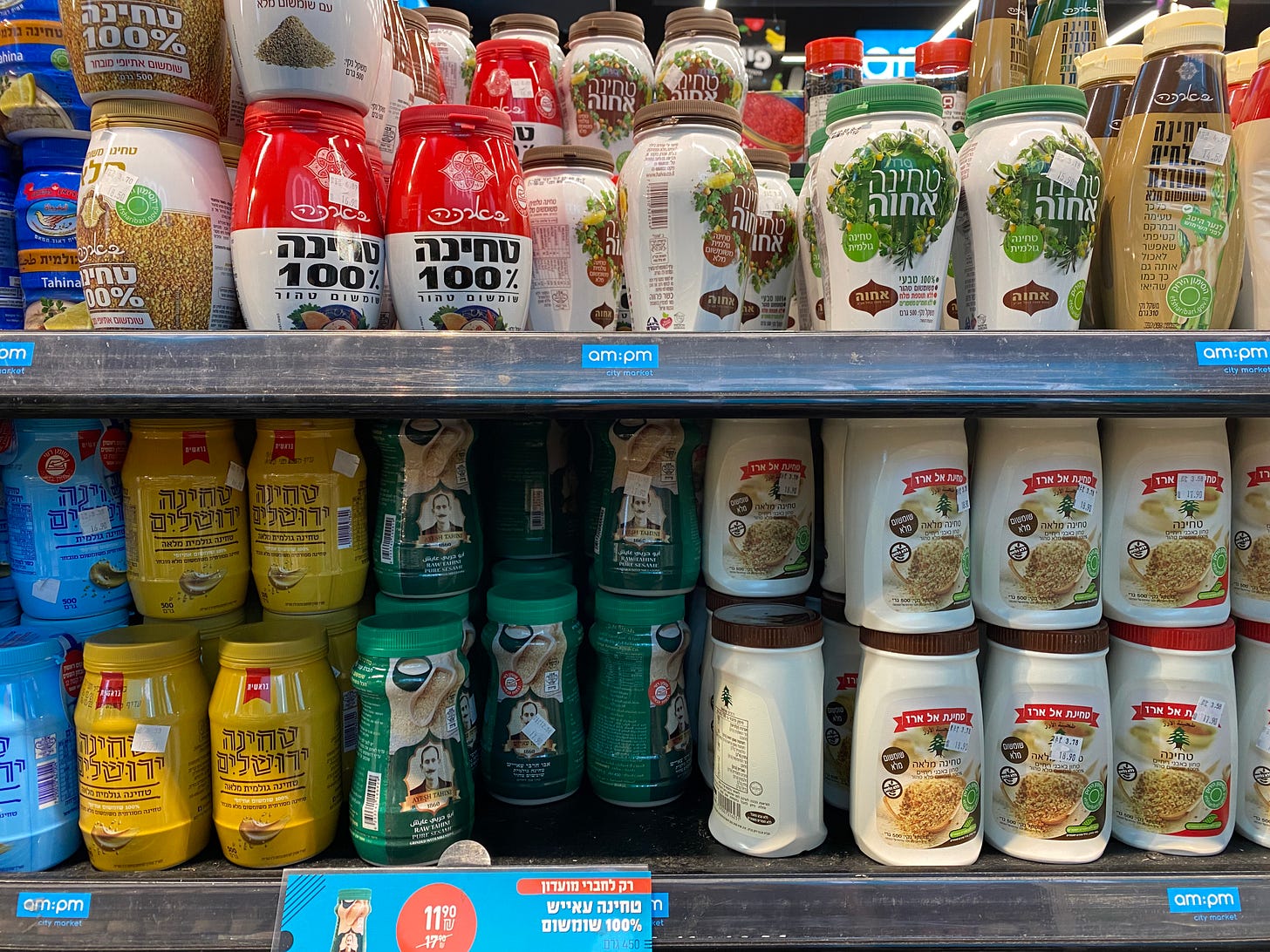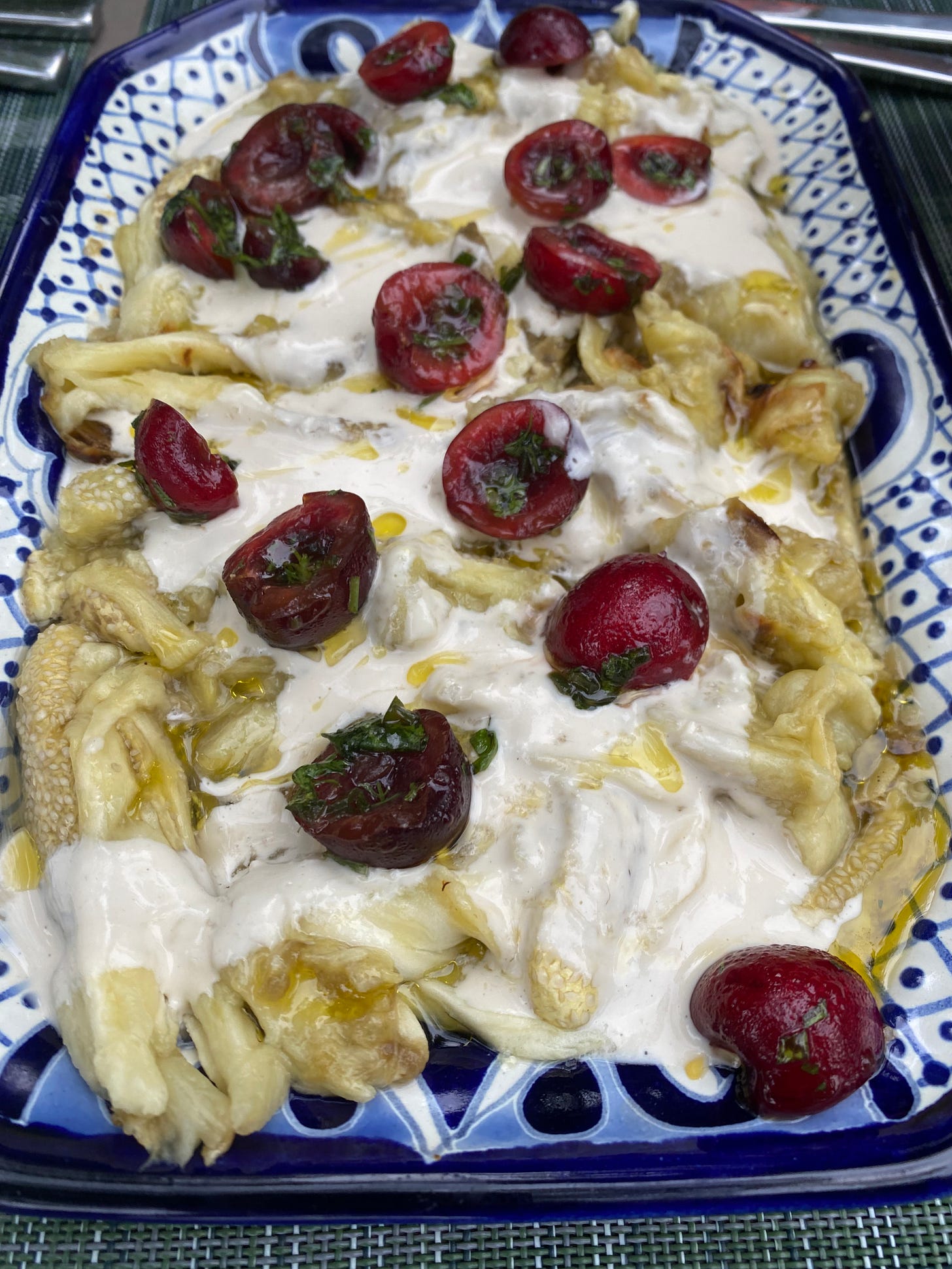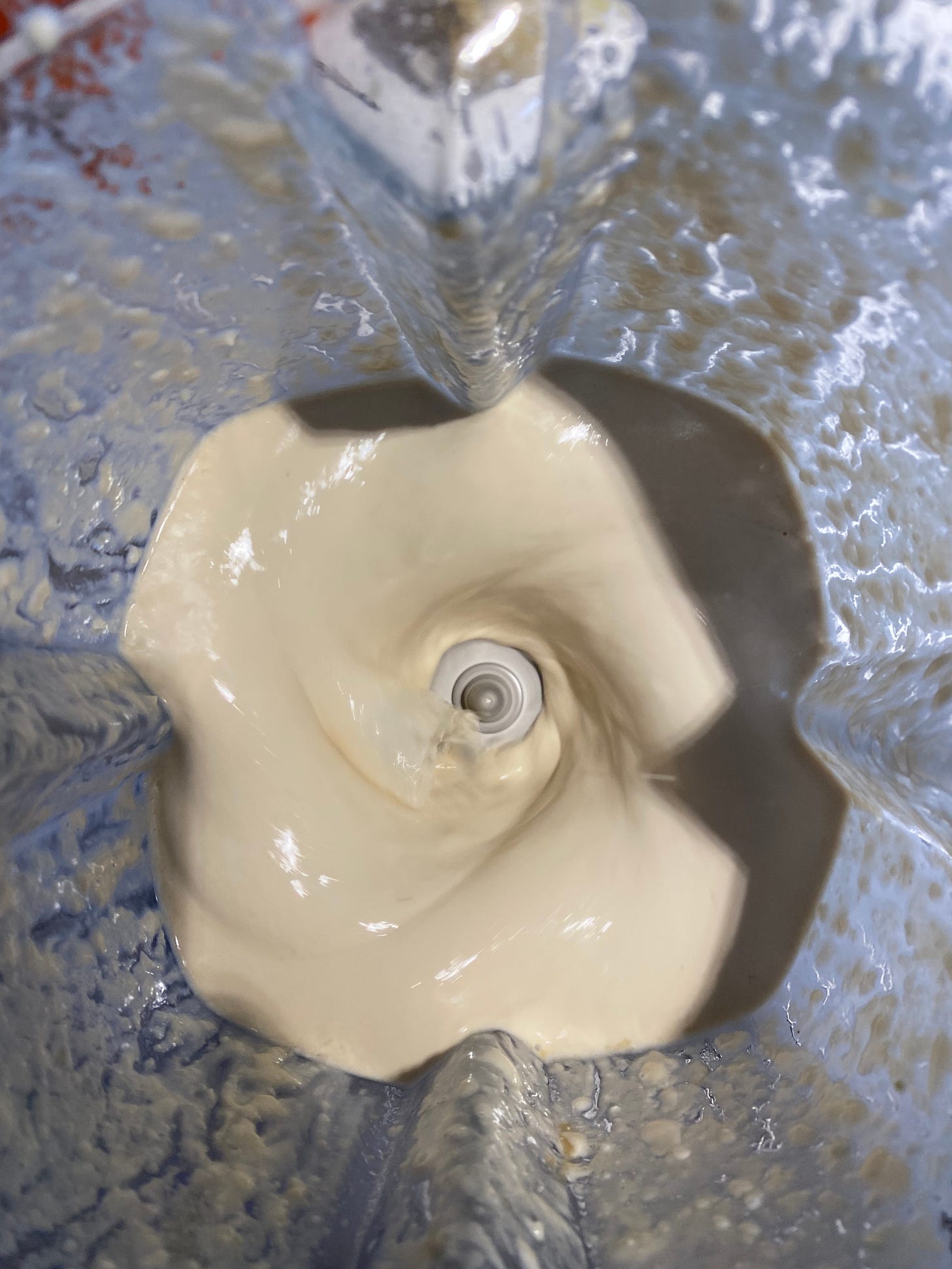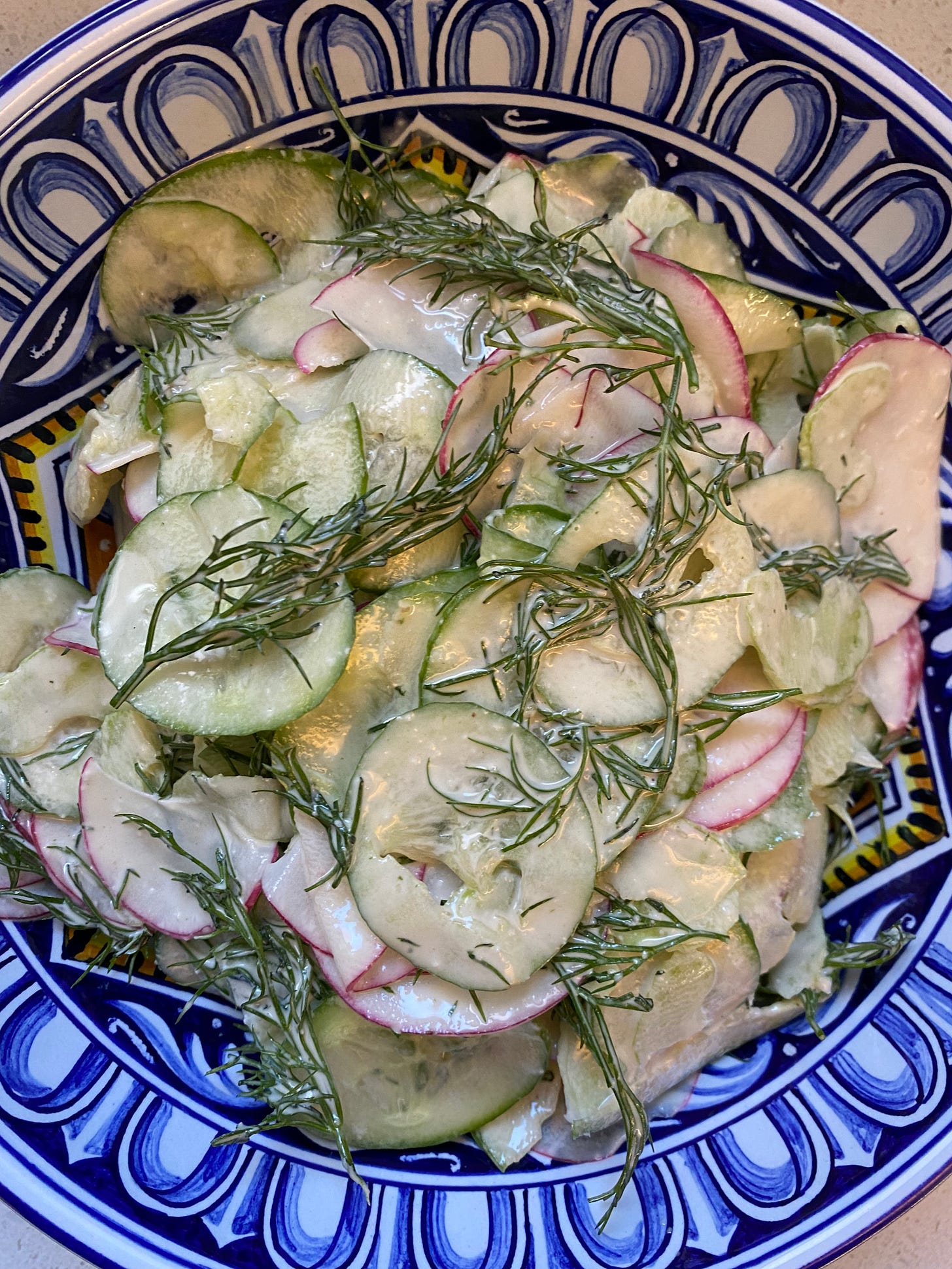🎶"You Say Tahini, I Say Tahina"🎶
Just Back from Israel, Where this Ubiquitous Sauce Is Much More than a Condiment
Here’s Issue #24, hot off the presses and fresh off the plane. I returned yesterday from Tel Aviv, where I saw the culinary cultural center and met the colleagues I’ve been working with since June for the first time. It was my first trip since COVID and it was such a treat to see Asif: Culinary Institute of Israel in real life. What a beautiful place. What an amazing group of people. What an important project. What delicious food. What a complicated part of the world. Asif has already begun to provide a space for important events and conversations that would be difficult to imagine taking place anywhere else in Israel—for example, Palestinian chef and cookbook author Sam Tamimi is speaking there on November 7. And I know Asif will continue to work toward their mission of exploring and nurturing the diverse culinary culture of Israel in creative, delicious and impactful ways for years and decades to come.
I started this issue of the newsletter while I was still in Tel Aviv, eating myself sick on the local, fresh, Mediterranean cuisine—full of vegetables, fresh herbs, olive oil, fresh cheeses and other cultured dairy products, fruits, grilled meats, and tahini. OK, not everything was full of tahini. In fact, my last restaurant meal before I left was a great dinner at the beloved Dok, where the chef/co-owner Asaf Doktor uses only produce grown in Israel and where, because Israel grows very little sesame, consequently you won't find much tahini. But Dok is the exception.

Every falafel, sabich, or other pita sandwich served in Israel has a dollop of tahini sauce. (There’s also usually the bright Iraqi amba, a pungent, turmeric-forward mango pickle condiment, but that’s a topic for another issue.) Tahini is a principal ingredient in the omnipresent hummus and in many other meze. It’s essential for eggplant baladi, the popular dish of roasted eggplant, pomegranate, and tahini, a sort of deconstructed moutabal, which also requires tahini. Fish is cooked in tahini. It is baked into babkas, brownies, danish, and cookies. It has become emblematic of Israeli food. My friend Amitzur Mor, executive chef of the modern Israeli restaurant Barbounia in NYC, goes through 400 pounds of tahini a week!
But what exactly are we talking about when we are talking about tahini? In its most basic form, tahini (pronounced something like “ta-cHee-nah” in Hebrew, with the “cH” meant to represent that distinctive, clearing-your-throat consonant) is the paste made from grinding hulled, raw or lightly toasted sesame seeds. It is different from, but related to Chinese sesame paste, which is made from darkly roasted sesame seeds. Humera, Ethiopia, is believed to produce the highest quality, most flavorful sesame seeds. (The most amazing sesame seeds I have ever tasted came from a 400-year-old shop in Kyoto, but I have no idea where those seeds were grown, probably Ethiopia.)
Every Israeli food lover has his or her favorite brand of tahini. The selection in most grocery stores is overwhelming to me, and not just because I can’t read Hebrew. Many brands come in the same plastic containers. So, I rely on my Israeli friends to give me their favorite tahini as gifts. And if I ever run out, I buy from local places like Soom and Seed and Mill. I’ll admit that while I can detect different flavors when I taste tahini brands side by side—some can be quite bitter, others can have an off, rancid taste, and the best are sweet and peanut buttery—by the time the tahini finds its way into hummus, I’m hard pressed to tell the difference.

What complicates things is that “tahini” is also the name given to the ubiquitous garlicky, lemony tahini sauce, which is also an ingredient in many dishes. I usually make a small batch of tahini (sauce) with a hand-held immersion blender, combining fresh garlic, a few heaping spoonfuls of tahini with some of its oil if it has separated, some lemon juice, a piece of preserved lemon or a teaspoon of preserved lemon paste, if I have it, salt and pepper, olive oil and enough water to bring it to the consistency I like. (Note that because you are making an emulsion, adding more water has the counterintuitive effect of making the tahini thicker, up until the point that it starts to thin.) I usually only make what I will use right away. I never measure. Most Israeli cooks would laugh at such a small amount, which usually suits me fine to dress a salad, sauce a roasted cauliflower, or mix into a spread.
Some 25 years ago, in my first cookbook, I recommended that you could put everything in a covered jar and just shake it until it emulsified, which you can do. But the other day, just before I left for Israel, coincidentally, I was making a larger batch than usual, and so I did it in my Vitamix blender. As with most things I put in that monster of a machine, the tahini came out smoother, creamier, and lighter than ever before. I couldn’t stop eating it with a spoon. I wiped out the blender with some stale challah I had lying around and ate all of that, too!
RECIPE: Tahini
(Makes 2 cups)
2 large cloves (20 g) garlic, peeled and roughly chopped
3/4 cup (180g) tahini
Juice of 2 small lemons (about 1/4 cup or 60 g)
3/4 cup (170 g) water
1 teaspoon preserved lemon paste or 1/2 a wedge of preserved lemon, rind and pulp (optional)
Kosher salt
1 tablespoon extra-virgin olive oil
In a powerful blender combine the garlic, tahini, lemon juice, 1/2 cup of the water, preserved lemon, if using, and a pinch of kosher salt. The amount of salt you will need depends on whether you are using preserved lemon, which can be quite salty. Start with a 1/4 teaspoon or so. Blend until smooth. With the machine running, add the olive oil. Stop the machine, taste, and adjust the taste and consistency with more of the water as desired. Note that the tahini will thicken as it sits and chills.
Now that you’ve made a vat of tahini, what should you do with it?
For starters, you can substitute this tahini for the same ingredients in my Roasted Squash Hummus recipe in Issue #19, or any hummus, for that matter, or pour it over the Roasted Cauliflower in Issue #4.
RECIPE: Tahini as Meze
Once rested and chilled your tahini “sauce” should be thick enough to spoon onto a plate or into a bowl. Garnish with any combination of olive oil, preserved lemon, za’atar, sumac, pomegranate seeds, toasted pistachios, sesame seeds, zhug, harissa, or other hot sauce, and serve it like a dip or spread for pita or other bread, vegetables, even fruits like apple, figs, or plums.
RECIPE: Cucumber, Radish, Dill, and Tahini Salad
Several years ago I had a lunch at Sara Jenkins’ late, beloved Porsena, during which she served a simple salad that sorta changed my life, in the way that only salads can (see Emily Nunn). Okay, I’m exaggerating, but it was so good and so simple I started making it all the time.

Thinly slice cucumbers, preferably the small Persian ones, and a few radishes diagonally on the bias to make big, floppy slices. I often add thinly shaved fennel, sliced Japanese turnips, and/or celery, too. (Note I can't live without my Kyocera ceramic mandoline, which makes preparing a salad like this really easy.) Add the fronds of a whole bunch of dill, a lot of them. You can also add fresh mint or other herbs. Add pinch of salt, some freshly ground black pepper, and toss with enough tahini sauce to coat. Note, it’s best to toss just before serving, as the salt will draw out moisture from the vegetables, making it watery.
RECIPE: Eggplant Baladi, My Way
I think my title for this recipe might mean “eggplant my way, my way,” but I’m sticking with it. A few years back I saw the esteemed Israeli food journalist (and friend) Ronit Vered give a fascinating talk on the origins of Eggplant Baladi, a dish popular throughout Israel of roasted eggplant, tahini, and garnishes that several Israeli chefs claim to have invented and that is probably more justly attributed to the Arab kitchen—which is true of many Israeli dishes and which doesn’t help the case against cultural appropriation. (Baladi means “local” or “rustic” in Arabic.) I make it all the time, by which I mean, I often throw together roasted eggplant with a bunch of things on a plate and pour tahini on top.

Roast 2 or 3 medium whole eggplants until blackened and soft. You can do this on a tray in a 450°F. oven, in a hot barbecue, covered or not, or over the flame of a gas stove. The time it takes will depends on the method, the size and moisture content of the eggplant. Your goal is to soften the flesh completely and blacken the skin to impart a smokey flavor, which can be anywhere from 20 to 45 minutes. Once done, set the eggplant in a colander in the sink. Slash the skin in a few places if it hasn’t burst already, and let it drain while it cools. Once cool, scrape the flesh off the skin onto a serving platter in an even layer. If you can easily remove the veins of seeds, do so, but I don’t think it’s necessary. Season with salt and pepper. Drizzle the tahini sauce, a little pomegranate molasses or dibs (grape must), or even some silan (date honey). Sprinkle with chopped herbs, pomegranate seeds, sugar, za’atar, or any of these in a combination of flavors you like. Serve with plenty of pita to mop the plate clean.
RECIPE: Fish Baked in Tahini with Caramelized Onions and Pine Nuts
I first saw this Palestinian dish in Sami Tamimi’s beautiful new Falastin cookbook. (Tamimi is partner in and culinary mastermind of the Ottolenghi restaurant and cookbook empire.) I had just made a big batch of tahini sauce so it was a no-brainer to give it a try. Glad I did.
Caramelize two or three finely sliced onions in olive or butter over medium heat until soft and golden brown, about 15 minutes. Meanwhile, season cod or other white fish fillets with salt, pepper, ground cumin, and a squirt of lemon juice. (Note this dish is quite rich, so you need less fish than you might for another preparation. Figure 4 to 6 ounces per person.) Dust the fish lightly with flour and fry in shallow olive oil until light browned on both sides. Transfer the fish to a baking dish that can hold the fillets in one layer. Once the onions are done, stir them into an ample amount of tahini sauce (it should cover the fish), along with sliced fresh chili, if you like spicy things, and spoon over the fish to coat. Sprinkle some pine nuts or chopped pistachios on top. Bake in a preheated 435°F. oven until bubbly and cooked through, 8 to 10 minutes. Sprinkle with a generous amount of coarsely chopped parsley, mint, dill, cilantro, or a combination, and some pomegranate seeds, if you have ‘em. Finely sliced or minced preserved lemon is also a delicious garnish. Serve hot or at room temperature.




